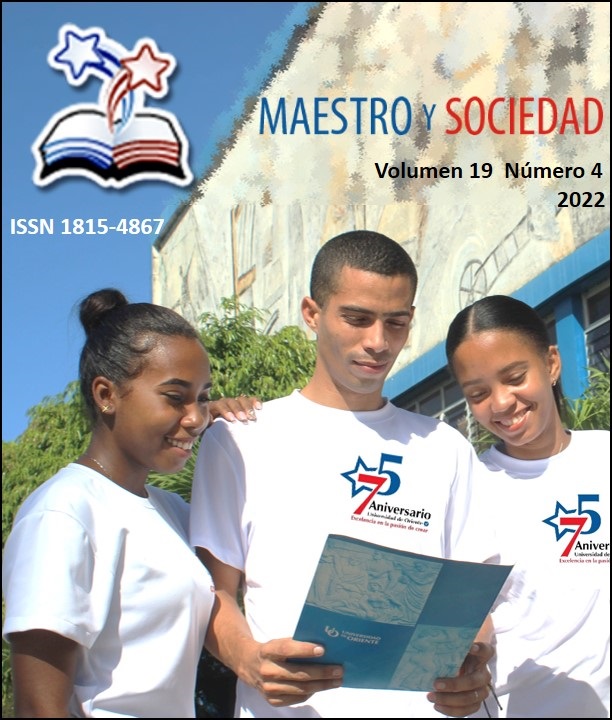Delivery of content in Virtual Teaching Environments Learning in higher education
Delivery of content in Virtual Teaching Environments Learning in higher education
Keywords:
Virtual surroundingses, Metodología, educational technologiesAbstract
With the integration of technologies and computer resources linked to the epidemiological situation of the country and the world, which have brought about new ways and strategies to continue the development of the country in all its social sectors, such as education; have forced the use of technology as a means of educational continuity. For this purpose, the objective of the research, to support the process of imparting professional content in the context of higher institutions of the Ministry of the Interior and its dynamics, through Virtual Teaching-Learning Environments. Although teachers use the e-mail activity to assign independent work to students, they do not favor the use of the blog option for the development of activities that promote individual work by students, eventually using the questionnaire activity to plan evaluation actions through the same; instead they develop the traditional evaluation through oral and written exams.
References
Andell, J. (1997). Tendencias de la educación en la sociedad de las tecnologías de la información. EDUTEC Revista electrónica de Tecnología Educativa, (7).
Area, M. (2003). Enciclopedia Virtual de Tecnología Educativa. http://www.ull.es/departamentos/didinv/tecnologiaeducativa/doc-ConcepMed.htm
Area, M. (2005). Las tecnologías de la información y comunicación en el sistema escolar. Una revisión de las líneas de investigación. Revista Electrónica de Investigación y Evaluación Educativa, 11(1).
Arias Rivero, E. (2016). Clic-Sistema de gestión de Materiales Educativos Digitales. Instituto Superior del MININT Eliseo Reyes Rodríguez “Cap. San Luis”. http://92.34.44.81/clic
Barreto, J. (2004). Hacia una educación audiovisual. Ed. Pueblo y Educación.
Beard, R. (1974). Pedagogía y didáctica de la Enseñanza Universitaria. Oikos-Tau S. A.
Bueno, M. J. (1996). Influencia y repercusión de las nuevas tecnologías de la información y de la comunicación en la educación. Bordon, Sociedad Española de Pedagogía, 48(3).
Candelario, O. (2005). SoftMusic, un software educativo para el proceso de enseñanza-aprendizaje de la Práctica Integral de la Lengua Inglesa I en el primer año de la carrera Licenciatura en Educación, especialidad Lenguas Extranjeras. [Tesis de Maestría. Instituto Superior Pedagógico “Félix Varela”].
Colectivo de autores. (2009). Libro de Texto de Informática. Instituto Superior del MININT Eliseo Reyes Rodríguez “Cap. San Luis”.
Colectivo de autores. (2013). Folleto de procedimientos esenciales de Informática Básica. Instituto Superior del MININT Eliseo Reyes Rodríguez “Cap. San Luis”.
Iparraguirre, S. (2021). Aula Moodle y el proceso de enseñanza aprendizaje en estudiantes de las carreras. (s.e.).
Pérez Omar, B. & .Velásquez, A. R. M. (2018). Aproximación teórica al estudio de las tecnologías y su importancia en el proceso de evaluación universitaria. Revista Cubana de Educación Superior, 37(3).
Pizarro-Blanco, Á., Sein-Echaluce, M. L. & García-Peñalvo, F. J. (2019). Tendencias educativas con Moodle: llevando el cambio metodológico al aula. (s.e.).
Valdés–López, M. & Troche–Isalgué, N. A. (2018). Las tecnologías de la Información y las Comunicaciones y los Entornos Virtuales de Enseñanza Aprendizaje. Santiago, (145), 15-26.
Published
How to Cite
Issue
Section
License
Copyright (c) 2022 Mayelnay Navarro-Duharte

This work is licensed under a Creative Commons Attribution-NonCommercial-NoDerivatives 4.0 International License.
This journal provides immediate open access to its content, based on the principle that offering the public free access to research helps a greater global exchange of knowledge. Each author is responsible for the content of each of their articles.



























 Universidad de Oriente
Universidad de Oriente 